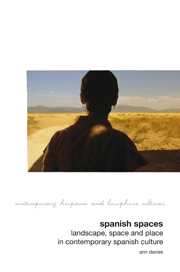Book contents
- Frontmatter
- Contents
- Acknowledgements
- List of illustrations
- 1 Introduction
- 2 Memory: landscapes of the past in Guillermo del Toro's Spanish films
- 3 Forgetting: the landscapes of Gonzalo Torrente Ballester
- 4 Landscape and identities in the Basque Country
- 5 Crime scene: landscape and the law of the land
- 6 Crime, scene, investigation: women, detection and the city
- 7 Coasting: tourism and landscape
- 8 Immigration: north (of) Africa
- 9 Conclusion
- Filmography
- Bibliography
- Index
8 - Immigration: north (of) Africa
- Frontmatter
- Contents
- Acknowledgements
- List of illustrations
- 1 Introduction
- 2 Memory: landscapes of the past in Guillermo del Toro's Spanish films
- 3 Forgetting: the landscapes of Gonzalo Torrente Ballester
- 4 Landscape and identities in the Basque Country
- 5 Crime scene: landscape and the law of the land
- 6 Crime, scene, investigation: women, detection and the city
- 7 Coasting: tourism and landscape
- 8 Immigration: north (of) Africa
- 9 Conclusion
- Filmography
- Bibliography
- Index
Summary
Spanish cinema has for many decades maintained a vein of film-making known as cine social, films that attempt to deal with social problems in a realist style; and this vein persists today even in an era when scholars and critics of Spanish film acknowledge a move towards more commercially orientated film-making that emphasises narrative and spectacle. Indeed, some filmmakers have combined the two, with Benito Zambrano's Solas (Alone, 2000), for instance, blending a sentimental tale of family and quasi-family relationships with a study of alcoholism and domestic abuse; or Alejandro Amenábar's Mar adentro (The Sea Inside, 2004), a biopic cashing in on the director's previous commercial successes that nonetheless raises the question of assisted euthanasia and a person's right to die. Similar phenomena occur when it comes to depicting the question of immigration. As Isabel Santaolalla has observed in her book Los ‘otros’ (Santaolalla 2005: chap. 1), race and ethnicity have been underlying preoccupations of some areas of Spanish film-making for many decades: nonetheless, depictions of immigration in particular have become prominent in the last two decades. This responds to wider concerns in contemporary Spanish society about immigration, particularly from the African coast, a concern exacerbated recently by the increasing influx of people trying to get to Spain from Africa and media coverage of both the human cost of this influx and the political conflicts engendered by the phenomenon within the Spanish communities most affected.
- Type
- Chapter
- Information
- Spanish SpacesLandscape, Space and Place in Contemporary Spanish Culture, pp. 142 - 163Publisher: Liverpool University PressPrint publication year: 2012

